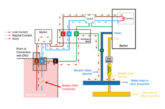
Paul Meenan CEng FIET of e5 discusses a common issue that is emerging and can be confusing for industry professionals.
It all started in early 2019, with a report of some form of arcing/sparking being witnessed on a main earth terminal/bar when connecting a new bonding conductor to it.
I know what you’re thinking: “what could possibly be causing that?”
It can’t be earth leakage, it’s a dead (or non energised) conductor; it’s a safety cable, in it’s simplest form earthing is only there to connect parts of the electrical installation to the general mass of earth… and:
a) Ensure disconnection of protective devices,
b) Ensure that all conductive parts are interconnected, so they remain at the same potential under fault conditions.
Besides, this is a bonding conductor, so what’s going on? Out comes the clamp meter and ‘Lo and behold’ we have 43.4 Amps!
Finding the fault
What is causing extraordinary volumes of energy to appear on a conductor designed only to carry voltage/current under fault conditions?
Now we’re on to the task of finding the fault. The quickest way was a call to the DNO and pop the fuses out after de-energizing the whole installation and yet we still find large amounts of current flowing.
 Here comes the weird part. The Electricity at Work Regulations 1989 (a book not visited enough, and some almost forget it exists) states electrical isolation is:
Here comes the weird part. The Electricity at Work Regulations 1989 (a book not visited enough, and some almost forget it exists) states electrical isolation is:
12.– (2) “isolation” means the disconnection and separation of the electrical equipment from every source of electrical energy in such a way that this disconnection and separation is secure.
So, how can you do that safely when this occurs? To answer this, we need to explore a phenomenon that is known to the Network Operators of the supplies (DNO or DSO). We may have heard it termed as a Broken PEN (Protective earth Neutral), Loss of PEN or DNC (Diverted Neutral Current).
We’ve been working with Tangle Tamers, an independent earthing consultancy, and putting a large amount of time into investigating and understanding what and why this happens.
Thankfully the IET has now acknowledged this isuue in its Wiring Matters March 2021 publication.
Now you could sum this up by looking at the photo at the top of the page, which shows an off-cut of two cables. The left is a CNE type, where the neutral and earth are combined. It’s also known as a PEN conductor used in a TN-C-S supply. The cable on the right is known as SNE (Separate Neutral and Earth), and is also what we’d class as a TN-S supply cable.
Now in theory, the DNOs shouldn’t mix cables, but this is where the problem lies – they do!
The cables pictured were jointed together when an old Paper Insulated Lead Covered (PILC) SNE cable underground was repaired with a CNE cable – the one on the left of the picture to be exact! This immediately links the N-E. So what looks at visual inspection like a TN-S system is actually a TN-C-S. And the frustrating part is the Network Operator did nothing, the DNO did nothing inside the installation to inform the owner of the installation or electrician(s).
Furthermore, research and email enquiries to the DNO were made and a response back that it would be wise to assume most supplies are now connected or converted in the street to TN-C-S – with the exception of TN-S supplies which can still exist but are likely only found on private networks.
 Note, I’m not calling it TN-C-S PME! PME (Protective Multiple Earth) describes the multiple rods or connection to earth the cable SHOULD have. Yet I don’t think many old converted cables, even at joints, are spiked with an electrode.
Note, I’m not calling it TN-C-S PME! PME (Protective Multiple Earth) describes the multiple rods or connection to earth the cable SHOULD have. Yet I don’t think many old converted cables, even at joints, are spiked with an electrode.
And yet we have the usual earthing system diagrams showing the different earthing systems – TN-S, TN-C-S, and TT – yet in reality we may find hybrids of these. Which begs another debate: do we need to re-assess and review the issue that over time earthing systems have been altered and become hybrids of those recognised? How do we deal with DNO safely?
Going forward, it may be worth electricians getting to know the MOCOPA guide as an addition to your CPD, put 105 in your phone and get to know your DNO engineers. Also, I’d recommend that you start checking earthing systems with clamp meters to protect yourself.
Sadly, our industry appears to be behind on managing energy concerning safe working processes. Just look at arc flash as another example.
WANT MORE INFORMATION?
Tangle Tamers, along with the e5 team, have produced a more in-depth guide that is available to view online. It shows what to look for and how to test for the presence of DNC. Years of research have gone into guide, and it appears evident electricians will have to start checking as part of their safe isolation procedure for not just voltage presence, but also current.
View the guide in full by clicking here
All pictures courtesy of Paul Meenan








